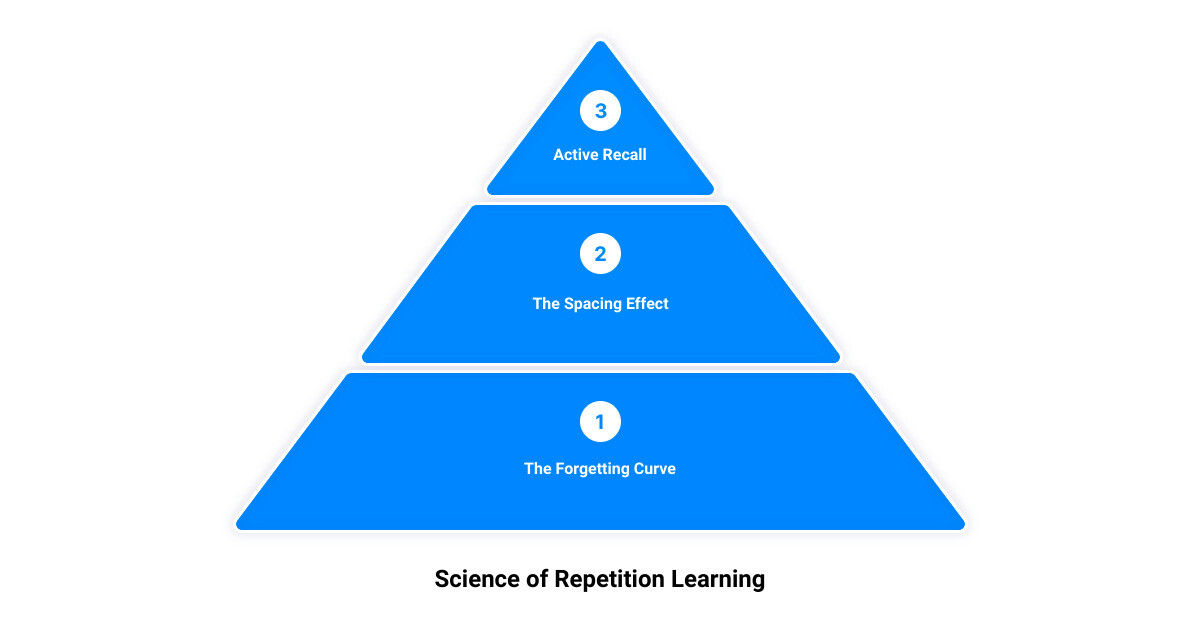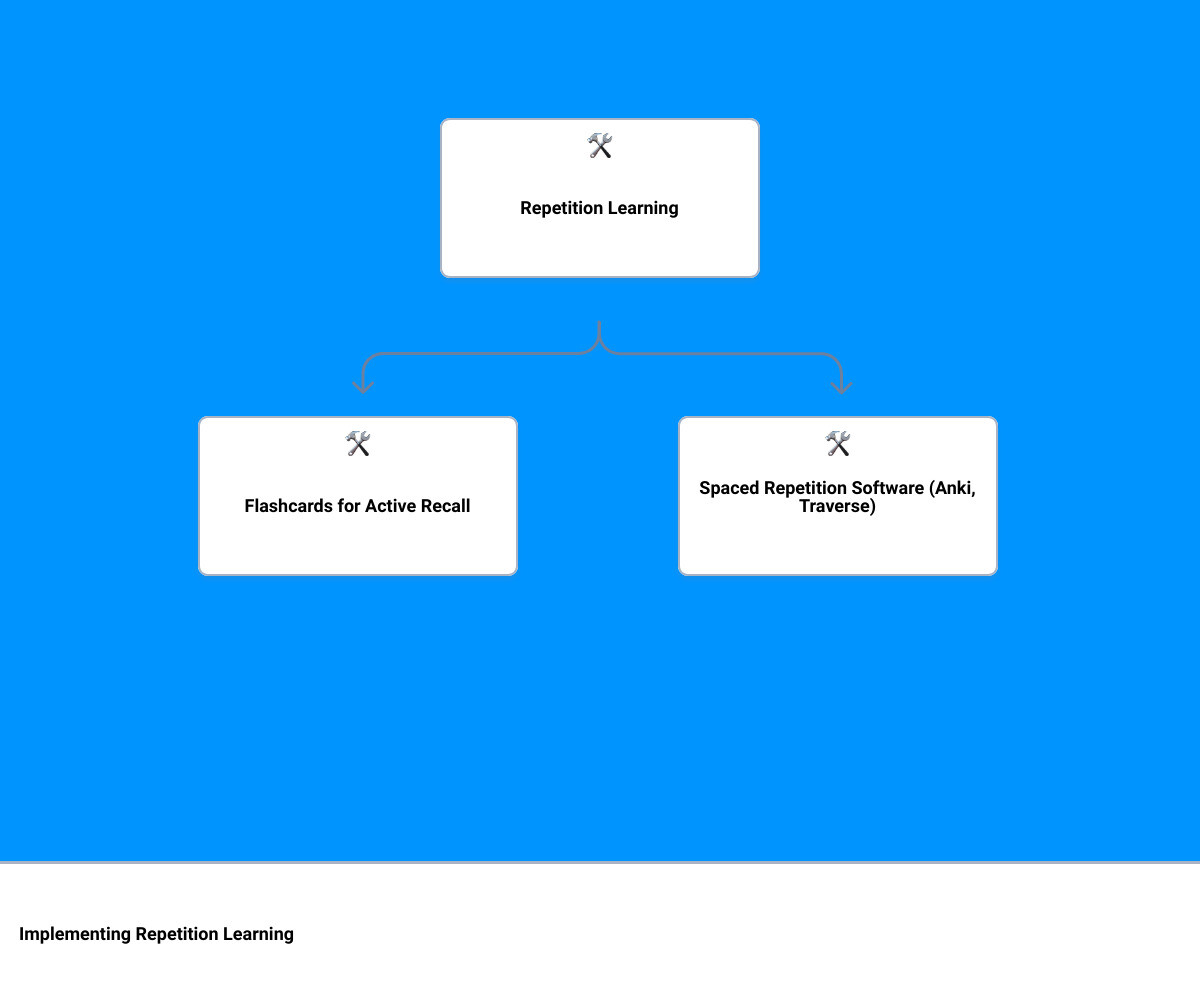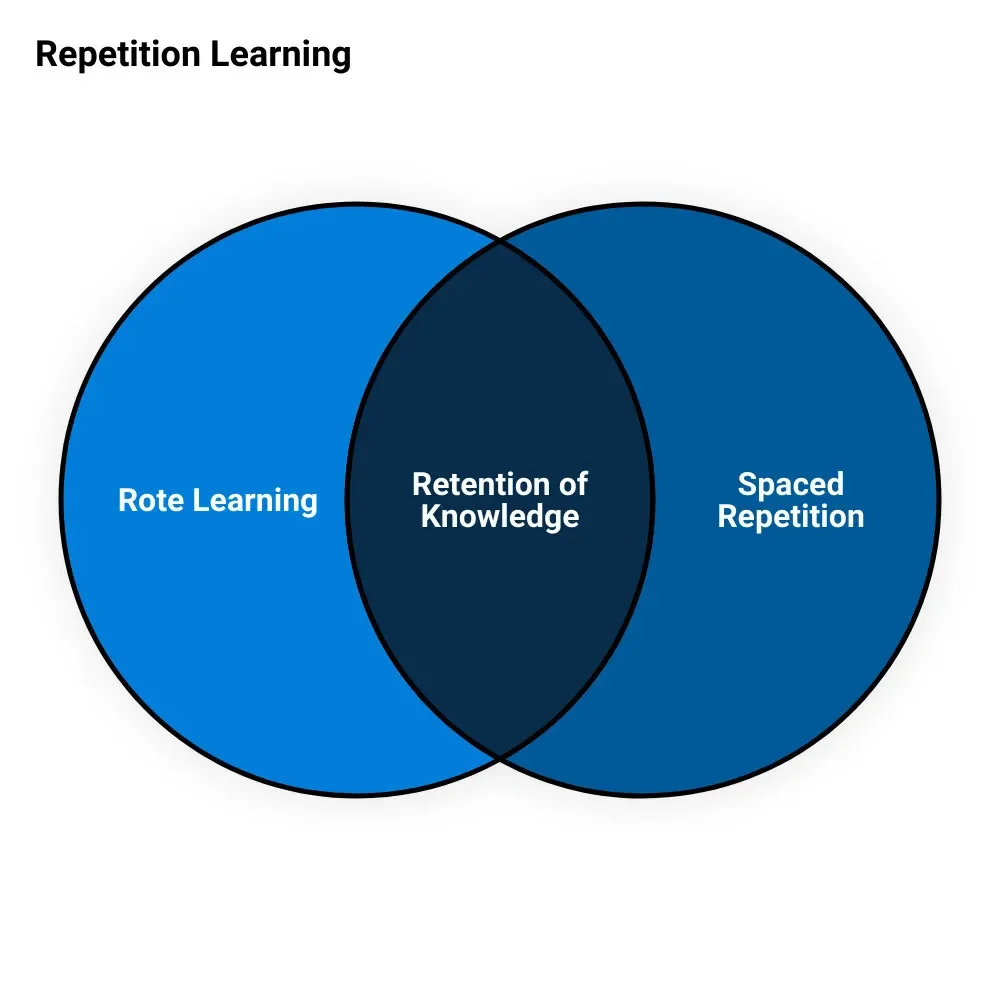In the world of learning, repetition reigns supreme. This statement is especially true when it comes to mastering complex languages such as Mandarin Chinese. In this article, we'll explore how the repetition learning method can unlock the power of your brain and turbocharge your journey to fluency. We'll delve into the cognitive science behind this method, revealing why it's so effective and how you can implement it in your own learning routine with the help of innovative platforms like Traverse.
The repetition learning method is not just for language learning; it's a universal tool that can be used to enhance comprehension and retention in any domain. Whether you're studying for a test, learning a new skill, or trying to remember important information, repetition can be your most valuable ally.
However, not all repetition is created equal. There's a world of difference between mindlessly repeating information and using scientifically proven strategies like spaced repetition and active recall. By understanding these methods and leveraging them effectively, you can transform your learning experience, making it more enjoyable and far more effective.
If you're a lifelong learner keen on mastering Mandarin or any other subject, stick with us. We'll demonstrate how you can harness the power of repetition to make your learning efforts more efficient and effective. It's time to unlock your learning potential with the repetition learning method. Stay tuned!
Understanding Repetition Learning: What is it?
Ever wonder how you still remember the alphabet or the multiplication tables from your early school years? That's the magic of repetition learning at work. Repetition learning is a method that facilitates the memorization of information through frequent exposure or practice. This technique can be categorized into two primary forms: rote learning and spaced repetition.
Rote Learning: The Basic Form of Repetition Learning
Think of rote learning as the bedrock of repetition learning. It involves memorizing information by repeating it over and over. From memorizing the alphabet to multiplication tables and even the periodic table, rote learning is a tool we've all used in our early education. While some critics argue that rote learning lacks depth, it's undeniable that it serves as a necessary step in learning certain subjects, providing the foundational knowledge required for more complex understanding.
Spaced Repetition: An Advanced Form of Repetition Learning
On the other hand, spaced repetition is a more advanced form of repetition learning. It's not just about repeating the information. It's about when and how you repeat it. The principle behind spaced repetition is simple yet effective; you review the information just before you're likely to forget it. This method is a game-changer in the learning arena. It leverages a memory phenomenon known as the spacing effect, where information is encoded more deeply into our brains when we engage with it over spread-out intervals.
Spaced repetition transforms the way we acquire and retain new information, making it a potent tool for mastering anything from complex scientific concepts to a new language like Mandarin. It's a gym workout for your brain, where your mental muscles get stronger and sharper with each repetition.
In the next sections, we'll dive deeper into the cognitive science principles that make repetition learning so effective and explore how you can use it to enhance your learning journey. Whether you're an aspiring polyglot or someone who simply enjoys learning, understanding repetition learning could revolutionize your learning process.

The Science Behind Repetition Learning
Ever wondered why cramming for exams often leads to forgetting everything right after? It's because our brains are wired for repetition learning. Let's demystify this with a deep dive into the cognitive science principles that make repetition learning so effective.
The Role of Active Recall in Repetition Learning
Active recall is the beating heart of repetition learning. It's the process of retrieving knowledge from your memory, a form of mental gymnastics that strengthens our memory muscles. Unlike passive review, where information is simply presented, active recall demands the brain to work harder. This difference can be likened to watching a workout video versus actually doing the exercises. Just as physical exercise strengthens muscles, active recall strengthens neural pathways.
In the realm of repetition learning, active recall is not a one-time activity. It's a continuous process, repeated at increasing intervals, that helps you battle against your brain's forgetting curve. This active engagement in recalling information, coupled with the optimal spacing intervals, forms the backbone of this powerful learning strategy.
The Spacing Effect: The Phenomenon Behind Spaced Repetition
The "spacing effect" is a memory phenomenon that forms the foundation of spaced repetition. It states that learning is more effective when study sessions are spread out over time. The intervals between study sessions are crucial in determining the effectiveness of your learning. Reviewing material too soon might be a waste of time, while waiting too long could mean having to relearn forgotten information.
The optimal time intervals for spaced repetition are influenced by several factors, including the complexity of the information, your familiarity with the material, and how long until you need to have the information fully memorized. The intervals generally start short, gradually increasing as your mastery of the subject grows.
The Forgetting Curve and How Spaced Repetition Fights It
The Forgetting Curve, a concept that illustrates the exponential decline in memory retention after first learning new information, plays a crucial role in spaced repetition. It shows that unless you actively review and recall the information, forgetting begins almost immediately after learning something new.
But here's the beauty of spaced repetition: every time you review the material just before you're about to forget it, you effectively reset your forgetting curve and strengthen your memory. It's like catching a ball just before it hits the ground and tossing it back into the air, each time throwing it higher and higher. This process allows you to remember the information for a longer period, making spaced repetition a powerful tool against the Forgetting Curve.
Understanding these cognitive science principles can revolutionize your learning process, making it more efficient and effective. In the next sections, we'll explore the practical steps and tools you can use to implement repetition learning in your study routine.
The Effectiveness of Repetition Learning
Repetition learning isn't just a buzzword in the realm of cognitive science, it's a scientifically proven method that holds the key to transforming the way we learn. This section aims to shed light on the effectiveness of repetition learning, focusing on how it facilitates knowledge transfer and enhances learning efficiency, as supported by numerous studies.
How Repetition Facilitates Knowledge Transfer
At the core of repetition learning is the process of transferring information from the conscious to the deeper levels of our memory. This process is crucial in ensuring that the knowledge we acquire doesn't just vanish after a short period of time. By repeatedly encountering the material, we are reinforcing the neural pathways in our brain, making the information more accessible and easier to remember. This concept is known as the consolidation of memories, and it is the foundation of long-lasting learning.
The Proven Benefits of Spaced Repetition in Learning
Known as the crown jewel of repetition learning, spaced repetition is a technique that strategically spaces out review sessions to maximize memory retention. The effectiveness of this method is well-documented in scientific literature.
For instance, a meta-analysis of 29 studies found that spaced practice, a key component of spaced repetition, outperforms cramming (also known as massed practice) by a staggering 74%. This demonstrates the power of spaced repetition in boosting learning efficiency.
Moreover, spaced repetition doesn't just target short-term memory; it enhances long-term memorization as well. By actively rehearsing the material in your mind, rather than passively consuming it, you're allowing your brain to build strong, long-lasting memories. This method facilitates the consolidation of new information with related knowledge that's already stored in long-term memory, making it easier to retrieve and recall the information at a later date.
Case Studies: Improved Test Results and Long-term Memorization
The merits of spaced repetition aren’t merely theoretical. Real-world applications have shown remarkable results. A study conducted by researchers at York University in Toronto revealed that students who applied spaced learning by taking a review quiz eight days after a lecture performed significantly better on their final exam compared to those who took the quiz only a day after.
Another study by Pashler, Rohrer, Cepeda, and Carpenter found that participants given spaced repetition tasks showed higher scores on a final test given after their final practice session. These findings suggest that spaced repetition not only improves long-term memorization but also boosts performance in assessments.
In conclusion, repetition learning, and more specifically spaced repetition, is a powerful, evidence-backed technique that can significantly enhance your learning efficiency and long-term memory retention. As you continue your journey in mastering Mandarin or any other subject, embracing repetition learning could be the game-changer you need. In the next section, we'll delve into practical steps you can take to implement this powerful learning method.

Implementing Repetition Learning: Practical Steps and Tools
Unleashing the potential of repetition learning is like discovering a secret weapon in your quest for knowledge. It's not just about understanding the theory; it's about taking that knowledge and putting it into action. Here's a roadmap to help you navigate the practicalities of repetition learning, from creating flashcards for active recall to leveraging software such as Anki and Traverse.
Creating Flashcards for Active Recall
Flashcards are the cornerstone of repetition learning. They leverage the power of active recall, a process that strengthens your memory connections. Instead of passively reading information, you're actively retrieving it, which cements it in your memory.
To create flashcards, start by gathering your study material from textbooks, lecture notes, or other sources. Next, transform your notes into question-and-answer flashcards. The question acts as a 'cue', while the answer represents the solution. Start reviewing your flashcards and repeat this process 2-3 days later, gradually extending the review intervals as you remember the information more easily.
Scheduling Reviews: The Optimal Spaced Repetition Schedule
The timing of your reviews is crucial in resetting the forgetting curve and enhancing long-term memory retention. A suggested schedule is to review the material 24 hours after the initial learning session, followed by reviews a week later, then two weeks, a month, two months, five months, and finally a year later. However, depending on your familiarity with the material, the complexity of the information, and your personal learning pace, you might need to adjust these intervals.
Using Software for Spaced Repetition: Anki and Traverse
While traditional paper flashcards are effective, digital options can offer additional benefits. Spaced repetition software such as Anki allows you to create flashcards with varying interval schedules. This software uses the SM-2 algorithm, which adjusts the frequency of flashcards based on your performance, ensuring that you spend your study time efficiently.
Meanwhile, Traverse takes the power of spaced repetition to the next level by integrating it with other effective learning strategies. You can build a 'tree of knowledge', connecting flashcards to corresponding notes and pages. This approach ensures that you're not just memorizing isolated facts, but understanding how they fit into a larger context. Traverse also allows for the import of Anki flashcards, combining the strengths of both platforms.
In conclusion, implementing repetition learning requires a strategic approach and the right tools. By creating flashcards for active recall, following an optimal spaced repetition schedule, and utilizing software like Anki and Traverse, you can unlock the full potential of repetition learning. Whether you're tackling Mandarin or any other subject, these steps will empower you to learn more effectively and efficiently.

Repetition Learning in Mandarin Chinese: A Case Study
The Challenge of Learning Mandarin Chinese
The journey to mastering Mandarin Chinese, like any language, requires a solid foundation in vocabulary and character recognition. But Mandarin presents unique hurdles due to its tonal nature and distinctive characters, markedly different from Western languages. The key to tackling this challenge? You guessed it: Repetition learning.
How Traverse and Mandarin Blueprint Leverage Repetition Learning
Traverse, a state-of-the-art learning app, has partnered with Mandarin Blueprint, an immersive language learning platform, to bring the power of repetition learning to Chinese language students. By using cognitive techniques like spaced repetition and active recall, they facilitate the acquisition of vocabulary and the understanding of complex Chinese characters. This dynamic duo has transformed the process of learning Mandarin, making it more effective and efficient.
The integration of learning techniques in these platforms is not random but scientifically backed. By having regular encounters with the material and gradually increasing the interval between these encounters, you're training your brain to store the information in your long-term memory. This method, known as spaced repetition, leverages a cognitive phenomenon called the spacing effect and is a powerful ally against the forgetting curve.
Traverse provides an all-in-one solution for mind mapping, flashcards, and note-taking, while Mandarin Blueprint offers an immersion-based learning experience. By learning characters and words in the context of real-life sentences and stories, you're not just memorizing; you're understanding and applying.
Importing Anki Decks into Traverse for Continued Learning
For learners who have already been using Anki, a popular flashcard software, for their Mandarin studies, Traverse has a fantastic feature: the Traverse Anki Importer. This tool allows you to import your Anki decks into Traverse, ensuring your previous hard work isn't lost. Instead, you can continue your learning journey with the added benefits of Traverse's advanced repetition learning techniques and the immersive content of Mandarin Blueprint.
Through this innovative use of repetition learning, you're not just studying Mandarin. You're preparing your brain for a lifelong relationship with the language, fostering long-term retention and understanding. The path to mastering Mandarin Chinese becomes less daunting and more achievable when you unlock the power of repetition learning.
Conclusion: Unlock Your Learning Potential with Repetition Learning
The road to mastery in any subject, like Mandarin Chinese, is paved with repetition. As we've explored, the power of repetition learning, particularly the advanced form known as spaced repetition, is a game-changer for lifelong learners. Backed by cognitive science, this method leverages the spacing effect and active recall to combat the forgetting curve and facilitate efficient knowledge transfer.
Spaced repetition isn't just about rote memorization; it's about reinforcing each learning encounter, cementing it in your memory. It's about training your brain to evaluate what's worth remembering, gradually shifting information from your consciousness to your long-term memory.
Remember, spaced repetition is not about cramming; it's about consistency. It's the methodical review and recall of information at optimal spacing intervals. It's about creating flashcards for active recall, scheduling reviews based on an optimal spaced repetition schedule, and using software like Anki and Traverse to help you manage your study sessions.
In our case study of Mandarin Chinese, we saw how the power of repetition learning can be harnessed to tackle the complexities of this language. By importing Anki decks into Traverse, you can continue to leverage this powerful learning strategy, making the daunting task of mastering Mandarin Chinese more manageable and achievable.
As a proactive learner, you are in control of your learning journey. Embrace the science-backed method of repetition learning and unlock your potential. With patience, discipline, and the right tools, you'll find yourself not just memorizing, but truly learning and retaining more than you ever thought possible.
So, are you ready to unlock the power of repetition learning? Your journey to efficient and effective learning awaits. Remember, the secret to mastery isn't about learning harder; it's about learning smarter. And repetition learning, especially spaced repetition, is a smart learning strategy that can help you reach your learning goals faster.

